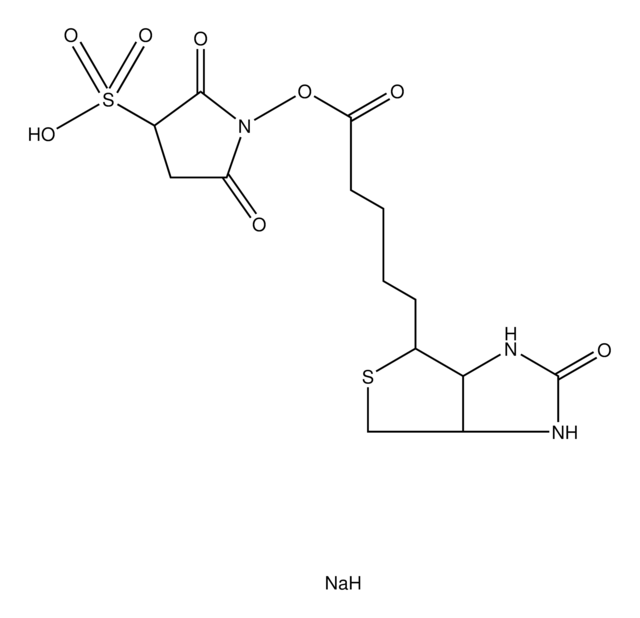935409
Sulfo-NHS-LC-LC-Biotin
≥95%
Synonym(s):
3-Pyrrolidinesulfonic acid, 1-[[6-[[6-[[5-(hexahydro-2-oxo-1H-thieno[3,4-d]imidazol-4-yl)-1-oxopentyl]amino]-1-oxohexyl]amino]-1-oxohexyl]oxy]-2,5-dioxo-, monosodium salt, [3aS-(3aα,4β,6aα)]-[partial]-, EZ-Link Sulfo-NHS-LC-LC-Biotin, Hexanoic acid, 6-[[6-[[5-[(3aS,4S,6aR)-hexahydro-2-oxo-1H-thieno[3,4-d]imidazol-4-yl]-1-oxopentyl]amino]-1-oxohexyl]amino]-, 2,5-dioxo-3-sulfo-1-pyrrolidinyl ester, sodium salt (1:1), Sulfo-NHS-XX-Biotin
About This Item
Recommended Products
Quality Level
Assay
≥95%
form
solid
storage temp.
−20°C
SMILES string
[Na].O=C1NC2CSC(CCCCC(=O)NCCCCCC(=O)NCCCCCC(=O)ON3C(=O)CC(C3=O)S(=O)(=O)O)C2N1
InChI
InChI=1S/C26H41N5O10S2.Na/c32-20(27-14-8-2-4-12-23(35)41-31-22(34)15-19(25(31)36)43(38,39)40)10-3-1-7-13-28-21(33)11-6-5-9-18-24-17(16-42-18)29-26(37)30-24;/h17-19,24H,1-16H2,(H,27,32)(H,28,33)(H2,29,30,37)(H,38,39,40);/t17-,18-,19?,24-;/m0./s1
InChI key
RWNPTJCDHAXLGI-BJPAGVOZSA-N
Application
Features and Benefits
Storage Class Code
11 - Combustible Solids
WGK
WGK 2
Flash Point(F)
Not applicable
Flash Point(C)
Not applicable
Certificates of Analysis (COA)
Search for Certificates of Analysis (COA) by entering the products Lot/Batch Number. Lot and Batch Numbers can be found on a product’s label following the words ‘Lot’ or ‘Batch’.
Already Own This Product?
Find documentation for the products that you have recently purchased in the Document Library.
Our team of scientists has experience in all areas of research including Life Science, Material Science, Chemical Synthesis, Chromatography, Analytical and many others.
Contact Technical Service







